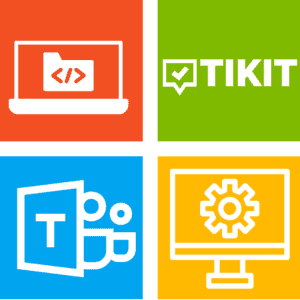Design an office space the right way and people might be brought into conversations they wouldn’t have had otherwise. Architecture affects how you move in a physical space. But you might not realize that the same is true in solutions architecture, which in Tikit’s case is thoughtfully enabling IT service desk problem solving and ticket management in a collaborative, conversational, innovative way.
Tikit is able to give you this experience because it is built on existing Microsoft architecture. The benefit for Tikit users, which includes help desk analysts, administrators, end users and other stakeholders, is that as Microsoft Teams evolves and is further integrated with complementary M365 technologies, Tikit will give you expanded functionality into these areas as well.
Let’s put this in more concrete terms with a feature called Adaptive Cards.
Microsoft Adaptive Cards: More Functionality Across More Microsoft Platforms
Microsoft defines Adaptive Cards as an “…open card exchange format enabling developers to exchange UI content in a common and consistent way.” A card is a JSON object that “…is rendered natively inside a host application, automatically adapting to the look and feel of the host.”
Basically, Adaptive Cards help you insert “actionable content” in apps. Because the cards morph and act as chameleons, they take on the look and feel of the app in which they present, giving you a native experience.
Tikit, which gives users a native experience in Microsoft Teams, uses Adaptive Cards. They are the basis of our templates and custom forms, used to condense and fully automate the ticketing process. Tikit can provide this flexibility, enabling analysts and end users to request and manage tickets in email and Teams chats (and our new Web UI), because adaptive cards provide the same experience—and the same formatting, inputs, configuration that you control. Information can be collected, contained and exchanged from app to app in a consistent way. From a user perspective, it’s seamless. You’ll feel that seamlessness when you try Tikit.
From a design perspective, capitalizing on Microsoft architecture and using adaptive cards in feature development gave us an easy way to exercise innovation and speed development. The cards are documented Microsoft pieces that can be used across the Microsoft ecosystem.
How do you benefit from Tikit’s architecture? You get:
- Innovative features that provide agility in ticket management
- A way to simplify aspects of IT service management (ITSM)
- A ticketing management system built on a cost-effective Microsoft Teams platform
- A platform that will be further integrated with additional Microsoft products
Talk about futureproofing.
Tikit Is a Great Investment—Especially for Microsoft Customers
More than 145 million users actively use Microsoft Teams, and it is included in Microsoft 365 Business subscriptions. So it’s a tool well within reach for most companies, and it has been widely noted as a facilitator for remote and hybrid work.
Teams is powerful, because it is evolving into a platform that supports business processes, applications and communication. It’s multifaceted and has value for small and midsize companies (SMBs) and enterprises. It also promises to be a prominent technology in today’s business climate and in the future.
The conversation, collaboration and engagement that Microsoft Teams enables come in handy in this new post-pandemic era of IT service desk management. Tikit is in a position to offer you new and dynamic ways to perform ticket management, aspects IT service management via Teams, problem solve across departments and apply ticketing to additional company processes—all while being able to understand, communicate and advise based on return-on-investment data.
Tikit’s got a lot more in store, which you can track on our Roadmap site. We’d love for you to benefit from it.
One of the things we’ll be covering in upcoming blogs are IT service management best practices, like ticket categorization, that are executed in innovative ways in Tikit. Check out this guide to find out about Tikit’s backstory and functionality: How Microsoft Teams Inspired Our Microsoft Teams Service Desk Solution. You can see how Tikit works in this demo. Or better yet, explore Tikit in a free 14-day fully-functional trial with no credit card needed!




